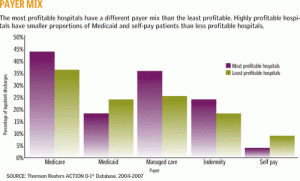
This time, hospitals may be pressured to change. The economy may be sluggish but publicly-traded hospitals continued to be profitable in 2011. But continued low admission rates, combined with growing enrollment in low-paying government programs, could give hospitals more incentive to pressure insurers for higher reimbursements during contract negotiations. Patient volume is improving, but not enough.
So, Are Hospitals Being Pressured To Alter The Way They Provide Care?
In mid-2011, commercial insurance enrollment increased, while Medicaid enrollment growth declined a bit. Despite this rise in commercially insured members, there seems to be a hesitation for actual health care utilization, probably because of continued economic instability and higher cost-sharing provisions in health plans. While low patient volume is a threat to the bottom line, low Medicare and Medicaid reimbursements are the biggest incentive for hospitals to pressure the insurers at the negotiating table.
Therefore, some hospitals might want to form new relationships with insurers. Health systems seem to preparing for a world where access to doctors and diagnostics, and cost control will matter more to their overall success and financial health than having a hospital in every part of the market. Consequently having increased emphasis on improved care management and better cost control will improve dealings with health plans as well.
With healthcare reform rolling out, it is a real possibility that new state-of-the-art ambulatory care centers could supplant inpatient facilities as the preferred strategy for market access. Plus the momentum toward more coordinated and patient-focused accountable care will continue among providers.
Additionally, publicly-traded hospitals could become a more attractive option in 2012 as usage increases among commercially-insured patients. Hospitals are much more sensitive to this than health insurers. An increase in the labor force also promises to be optimistic for providers. Long-term unemployment and the number of part-time workers as a percentage of the work force are higher, which could potentially hold down utilization levels. Yet, as overall utilization improves, even slowly, hospital perception levels will decline as less critical patient procedures return to the market.
To counter pressures, including a rapidly increasing Medicare payer mix, hospital systems will need long-term cost reductions of 20% to 25%. Hospitals will apply strong cash generation to acquisitions to help counter flat organic growth. Some hospital systems have taken advantage of favorable conditions in the bond market and have renegotiated credit agreements to refinance debt and extend maturities.
But even with available cash, hospital systems might not want to target acquisitions due to uncertainty surrounding the Supreme Court’s ruling on key provisions of the reform law and the November elections. The differing agendas of politicians could lengthen due diligence and slow down deal volume. And if the court strikes down key provisions, such as the development of ACOs, the purchase of physician practices by hospitals would likely decrease. However, the primary causes for consolidation, like capturing market share, improving access to capital, and finding new efficiencies, all remain in place as viable. Do you think hospitals may be pressured to change?
